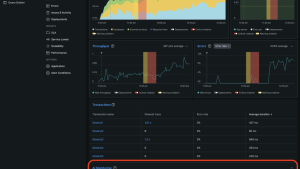Mitigating technical debt emerges as a critical challenge that directly affects code quality, project timelines, and overall efficiency. But application performance monitoring (APM) offers a strategic solution poised to redefine this challenge.
APM offers a proactive approach to technical debt reduction through automated testing, code review enhancements, and streamlined refactoring. Discover how APM's multifaceted applications are now a beacon of efficiency and innovation in the realm of technical debt management.
Understanding technical debt
Technical debt is a concept in software development that refers to the implicit costs associated with choosing an easier or quicker solution instead of a more optimal but potentially more time-consuming or complex approach. It's a metaphor coined by Ward Cunningham, a computer programmer who co-authored the Manifesto for Agile Software Development, to describe the trade-offs made during the development process.
Just like financial debt, technical debt accrues interest over time. When developers choose a shortcut, skip documentation, or neglect refactoring, they accumulate technical debt. This can lead to challenges in the future, including increased maintenance costs, reduced development speed, and decreased overall system stability.
Consequences of unresolved technical debt
If left unaddressed, technical debt can have far-reaching consequences that extend beyond the digital realm. Understanding these consequences is crucial for businesses aiming to maintain a healthy and efficient software development lifecycle.
Code quality, once pristine, succumbs to degradation, inviting a surge in defects that compromise system integrity. Project delays become an inescapable reality, each day carrying financial implications that reverberate through budgets and timelines. Yet, the consequences stretch beyond mere financial metrics. There's a direct correlation between unresolved technical debt and team morale. As the burden intensifies, so does the toll on motivation and cohesion within the development team.
For business decision-makers, it’s important to translate these technical intricacies into real monetary terms they can understand. This shift in perspective is not just an acknowledgment of a technical challenge; it's a strategic move, recognizing technical debt as a pivotal factor with profound business implications. This understanding elevates the urgency of mitigating technical debt from a technical necessity to a core business imperative.
Using APM as a tool to reduce and manage technical debt
APM emerges as a dynamic tool in the arsenal against technical debt. Its application goes beyond conventional monitoring, actively contributing to debt reduction strategies in the following ways:
- Automated testing: Through APM-enabled automated testing, potential issues are detected early in the development process. This not only prevents the escalation of technical debt but also enhances overall code quality and performance, fostering a proactive approach to software development.
- Code review practices: APM facilitates robust code review practices, promoting knowledge sharing among team members. By reducing errors and ensuring adherence to best practices, APM becomes an ally in minimizing the introduction of technical debt during the development lifecycle.
- Refactoring for code health and complexity reduction: APM plays a pivotal role in maintaining code health and reducing complexity. By providing insights into areas that demand attention, APM guides effective refactoring efforts, directly contributing to technical debt reduction.
- Metrics tracking for informed decision-making: APM's metrics tracking capability becomes a compass in the journey of technical debt reduction. It enables development teams to monitor progress, identify persistent pain points, and make informed decisions to streamline their debt reduction efforts.
- Organizational impact: Beyond the technical sphere, APM influences organizational culture. It aids in addressing the root causes of technical debt, fostering a cultural shift toward proactive debt management. APM becomes a strategic force aligning organizational practices with the goal of sustained debt reduction.
Collaboration and listening: Involving engineers in the APM process creates a collaborative environment where insights are shared and potential issues are proactively addressed. APM facilitates a culture of listening to the needs and experiences of the development team, enhancing the collective intelligence applied to technical debt reduction.
Preventative measures and agile adaptation
APM empowers development teams by shedding light on critical areas and enabling prioritization of requirements. This foresight ensures early intervention, aligning project goals with effective technical debt management.
By offering real-time performance insights, APM becomes the compass for agile adaptation. It ensures swift adjustments to evolving project scopes, maintaining resilience within agile methodologies.
Proactive monitoring not only guards against technical debt but actively contributes to scalable architectures and informed team augmentation. Moreover, it aids in strategic decisions on team augmentation, ensuring the right resources are in place to address project demands and minimizing the risk of accumulating technical debt.
Continuous improvement and collaboration
APM emphasizes continuous debt management, transforming the approach from sporadic interventions to an ongoing, systematic process. By providing real-time insights into system performance, APM allows teams to proactively address potential debt accumulation, fostering a culture of constant vigilance.
APM encourages organizations to view debt reduction as integral to their ongoing software development lifecycle. By integrating debt reduction into the routine, teams mitigate immediate risks and create a sustainable framework that guards against the accumulation of technical debt over time.
Regular evaluations and adjustments are paramount for effective technical debt reduction. APM facilitates this by offering continuous visibility into performance metrics. Teams can assess the impact of their debt reduction strategies, make informed adjustments, and ensure that their efforts align with evolving project requirements and industry best practices.
Partnering with technology experts for effective debt handling
Collaboration with technology experts becomes a strategic imperative in mastering technical debt. APM advocates partnering with specialized agencies or experts who bring nuanced insights and best practices. This collaborative approach ensures that debt reduction efforts are informed, targeted, and aligned with industry standards.
Working with external specialists allows the teams to tap into a wealth of experience and knowledge. This external perspective can provide fresh insights into debt reduction strategies and ensure a continuous learning process that fortifies the organization against future debt challenges.
How to manage technical debt for the long term
APM shifts the focus beyond short-term fixes, encouraging teams to envision the long-term advantages of a software ecosystem free from the shackles of technical debt. Utilizing APM is critical to embedding ongoing practices for sustainable debt reduction. APM's continuous insights empower teams to monitor and address technical debt in real time, integrating debt reduction seamlessly into the development lifecycle.
APM provides actionable recommendations for incorporating debt management into the development lifecycle. By aligning monitoring insights with development processes, teams can proactively address potential debt accumulation, ensuring that debt management becomes an integral part of their workflow.
It’s important to maintain momentum with APM for long-term technical debt reduction. APM advocates periodic evaluations, adjustments, and the continuous pursuit of improvement. Tips include setting measurable goals, regular team training, and leveraging APM's insights to track progress, ensuring sustained momentum in the journey towards a debt-resilient software landscape.
Managing technical debt with New Relic
Managing technical debt effectively is not just a technical necessity but a strategic imperative for any forward-thinking organization. The advantages of reducing technical debt over the long term are numerous, ranging from improved code quality and system stability to increased developmental efficiency. These benefits extend far beyond the immediate gains, nurturing a resilient, agile, and future-proof software ecosystem.
One of the key tools for sustainable debt reduction is application performance monitoring, such as New Relic APM. New Relic APM capabilities offer critical insights into system performance, empowering teams to proactively identify and resolve issues. By integrating these tools into the development lifecycle, organizations can continually oversee and manage their technical debt, transforming a once reactive approach into a strategic initiative.
By embracing these practices and tools, organizations can manage their technical debt and turn their software development processes into a key driver of business success.
Les opinions exprimées sur ce blog sont celles de l'auteur et ne reflètent pas nécessairement celles de New Relic. Toutes les solutions proposées par l'auteur sont spécifiques à l'environnement et ne font pas partie des solutions commerciales ou du support proposés par New Relic. Veuillez nous rejoindre exclusivement sur l'Explorers Hub (discuss.newrelic.com) pour toute question et assistance concernant cet article de blog. Ce blog peut contenir des liens vers du contenu de sites tiers. En fournissant de tels liens, New Relic n'adopte, ne garantit, n'approuve ou n'approuve pas les informations, vues ou produits disponibles sur ces sites.





